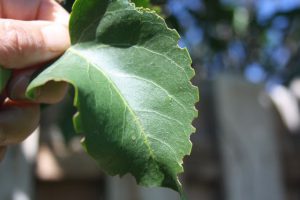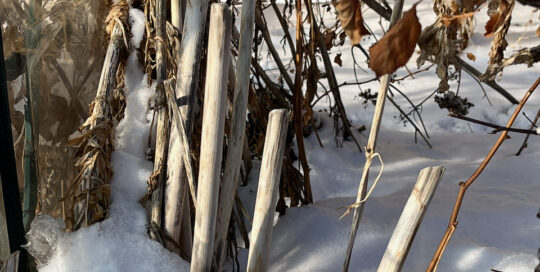Why do the lilac leaves looking like someone trimmed them with pinking shears?
Views: 7360

Every summer it looks like someone took pinking shears to the leaves on my peonies and lilac leaves, but I always figured it was grasshoppers. It wasn’t until we stopped by a neighbor’s place during one of our evening bike rides that she showed me her ragged looking lilacs that I wondered if something else was going on with a local pest. Then when another friend sent me a message describing the same situation, I knew something else had to be the culprit.
My first thought when I saw the lilac leaves was it was leaf cutter bees. Since they are excellent pollinators and good characters to have around, I suggested she just let it go. But there was so much chewing done, and she never saw anything on the leaves, that I kind of wondered if there was something attacking the leaves at night.
The culprit
The next thought was it could be earwigs. Even though I’ve read time and time again that they don’t cause damage, I’ve seen the reality. Finally, after some searching, I figured it out. It has to be root weevils. I didn’t even know we had root weevils, let alone that they did this sort of damage to foliage. In my research, I learned there are over a dozen species in our area, including the strawberry root weevil, black vine root weevil, and the lilac root weevil. And besides enjoying the peonies and lilacs out here, they have a penchant for rhododendrons and azaleas in other parts of the country.
Since their name implies that they live in the soil, you might notice the presence of root weevils if you have young plants wilting and dying from their feeding on the roots, although this typically is not a severe issue. The more visible indication of their presence is nibbling the leaves in this distinct pattern. When the adults emerge, they crawl up the stems or branches of the plants to feed on the leaves during the night. If you really want to see them in action, go out on a warm summer night with a headlight to catch them in the act. You can also put a dent in their numbers at this time by shaking the branches over a white sheet or sheets of newspaper that you can gather up and toss into the trash.
What to do
Another way to slow them down is to trap them on the way up. If you have the sticky traps with the paper backing, you can secure those around the tree or plant. But you can also use a substance like Tanglefoot, although you will first have to wrap the tree with cardboard or paper, then smear the Tanglefoot over it, or you’ll have a branch covered in gross, dead bugs. Once you capture a lot of them, tear off the cardboard and dispose of it.
Most of the time, the feeding does not hurt the tree or plant, but if it is in a visible area and you want to stop it immediately, you can spray the tree and the soil with insecticides made with Neem, Permethrin, or Spinosad. You will have to treat them with numerous applications every 2-4 weeks (read the labels of the specific insecticide) to stay on top of them.
Root weevils aren’t horrible in the sense that they kill the plants, but it’s really remarkable at how much damage they can do. Fortunately, if you don’t want your lilac leaves to look like a kindergartener’s craft project, there are a number of ways you can knock back their numbers.
Meet Amy Grisak
Amy is a freelance author and photographer in Great Falls, MT who specializes in gardening, foods, and sustainable agriculture. She provides information on every kind…
Amy's Recent Posts

This Little Piggy is a Problem: Dealing with Feral Hogs








